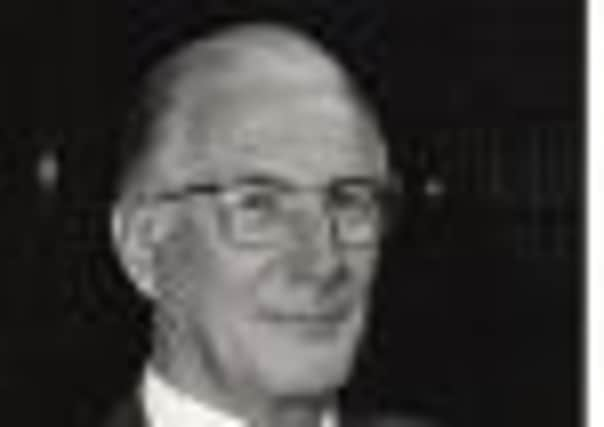Obituary: Professor John A Strong, CBE, physician and medical academic at the University of Edinburgh


PROFESSOR John Strong was involved with the University of Edinburgh for more than 60 years, starting as a lecturer in medicine from 1949, having served in the Royal Army Medical Corps during the Second World War. He was given his own personal chair as professor of medicine in 1966 and, after retirement, was named professor emeritus in 1981, a title held until his recent death. From 1979-82, he served as president of the Royal College of Physicians of Edinburgh, where he was a driving force – including raising funds – behind the creation of what has been described as “his baby,” the Royal College’s much-admired Queen Mother Conference Centre, whose foundation stone was laid in 1994.
An expert in endocrinology – the study of the endocrine glands – he was widely known in the medical, scientific and academic communities for helping discover chromosomal abnormalities that explained certain “intersex” or other congenital syndromes. “Intersex” refers to the rare condition in which a person is born with, or later develops the anatomical, psychological or behavioural features of both male and female, often leading to severe personal suffering.
Advertisement
Hide AdAdvertisement
Hide AdOne of his most famous publications, jointly written with Dr PA Jacobs in Nature magazine in 1959, involved chromosome abnormalities in males with Klinefelter’s syndrome –also known as XXY Syndrome, when males have at least one extra chromosome, which can lead to infertility.
Also an expert in nuclear medicine – involving the application of radioactive substances – Prof Strong was not only a fellow and past president of the Royal College of Physicians of Edinburgh but also a fellow of the Royal College of Physicians in London and of the Royal Society of Edinburgh.
He was an honorary fellow of the American College of Physicians, of the Royal College of Physicians of Ireland, of the College of Physicians of Philadelphia, of Trinity College, Dublin, and of several other institutions. He was also for many years a member of the Lothian Health Board.
Having been awarded an MBE for his military service with the Royal Army Medical Corps in 1942, where he was mentioned in dispatches, he was appointed CBE in 1978 for his civilian medical work. The RAMC also awarded him the honorary rank of Lieutenant-Colonel.
John Anderson Strong was born on 18 February, 1915, to Charles and Mabel Strong, in what was then the small village of Kells in Co Meath, Ireland, now popular with many commuters who work in Dublin. He was sent to England to attend the Kingsmead preparatory school in Hoylake, on the Wirral peninsula, and later to Monkton Combe, at the time an all-boys’ independent school, near Bath, Somerset. He returned to Ireland to study medicine and had just graduated when war became inevitable. In October 1939, with the war under way and the future uncertain, he married Moira Heaney, a Liverpool surgeon’s daughter who would remain the love of his life. She had qualified in medicine but later gave up her career to support her husband.
Having obtained a pilot’s licence just before the war, Strong applied for the Royal Air Force, but it was oversubscribed so, instead, he joined the RAMC. It was a decision that pleased his wife, given the RAF’s casualty rate – although he would see plenty of frontline action during the allies’ Burma campaign against the Japanese empire, especially in the Assam Hills of India.
He was responsible for setting up two hospitals in Assam, which first treated refugees fleeing the Japanese advance, and he commanded a casualty clearing station near the front lines, once fleeing with staff and patients into the jungle to hide from the Japanese. Like many, if not most war veterans, he rarely talked about those days.
Back in civilian life, he trained at what was then the West London Hospital on Hammersmith Road before he was interviewed in 1948 – partly at the bar of Edinburgh’s North British Hotel – by Sir Stanley Davidson, then professor of medicine at the University of Edinburgh. Suitably impressed, Sir Stanley appointed him senior lecturer in medicine, along with the post of honorary consultant physician at the Western General Hospital, affiliated with the university – all of this in the early days of the NHS. At the Western, he raised funds for a metabolic unit to study patients with such conditions as diabetes and obesity.
Advertisement
Hide AdAdvertisement
Hide AdFrom 1976-83, he was a member of the UK Medicines Commission (now part of the Commission on Human Medicines), which advises government ministers on the regulation of medicinal products. Having been elected president of the Royal College of Physicians of Edinburgh shortly before his retirement from the university and the NHS, he played host to the Queen when she visited the Royal College to mark its tercentenary in 1981.
Prof Strong was a keen fisherman, stalker, golfer and student of national history. He fished regularly with his brother in Ireland and, after retirement, on the River Tweed or in Wester Ross. He liked to stalk with medical colleagues in the Highlands near the village of Laggan, better-known to some TV viewers as the village of Glenbogle in the drama series Monarch of the Glen. He was also a member of the Honourable Company of Edinburgh Golfers at Muirfield.
Prof Strong died in Chamberlain Nursing Home, Edinburgh, where his carers described him as their most-popular and most-visited resident. His wife Moira died in 1997. He is survived by their son Anthony, a retired neurosurgeon, daughters Elizabeth, an antiquarian bookseller in Edinburgh, and Jane, and their extended families.
PHIL DAVISON